

Calling all gamers! Whether you consider yourself a competitive pro or someone who’s more casual, we’ve got quite the diverse list below. The best part is that every gaming laptop has been tested by a member of PCWorld and we’ve checked out everything from graphics performance and typing experience to connectivity options and image quality. These rigs can basically do anything a desktop PC can do, and we’ve tested dozens after dozens of them to bring you this roundup of the best gaming laptops around.
Looking for deals? Check out PCWorld’s roundup of the best Black Friday laptop deals available right now.
[ Don’t miss: Here’s how to get the best prices on tech this Black Friday, and where to shop.
]
Why you should trust us: It’s in our name! PCWorld prides itself on laptop experience and expertise. We’ve been covering PCs since 1983, and we now review more than 70 laptops every year. All of the picks below have been personally tested and vetted by our experts, who’ve applied not only performance benchmarks but rigorous usability standards. We’re also committed to reviewing gaming laptops at every price point to help you find a machine that matches your budget.
Quick retail links to some of our top picks:
Best overall gaming laptop: Alienware m16 R2Best gaming laptop under $1,000: Acer Nitro VMost portable gaming laptop: HP Omen Transcend 14
It’s that time of the year again, and laptop deals this Black Friday season have never looked better. Check out our roundup of the best Black Friday laptop deals to help with your laptop purchase.
Alienware m16 R2 – Best overall gaming laptop
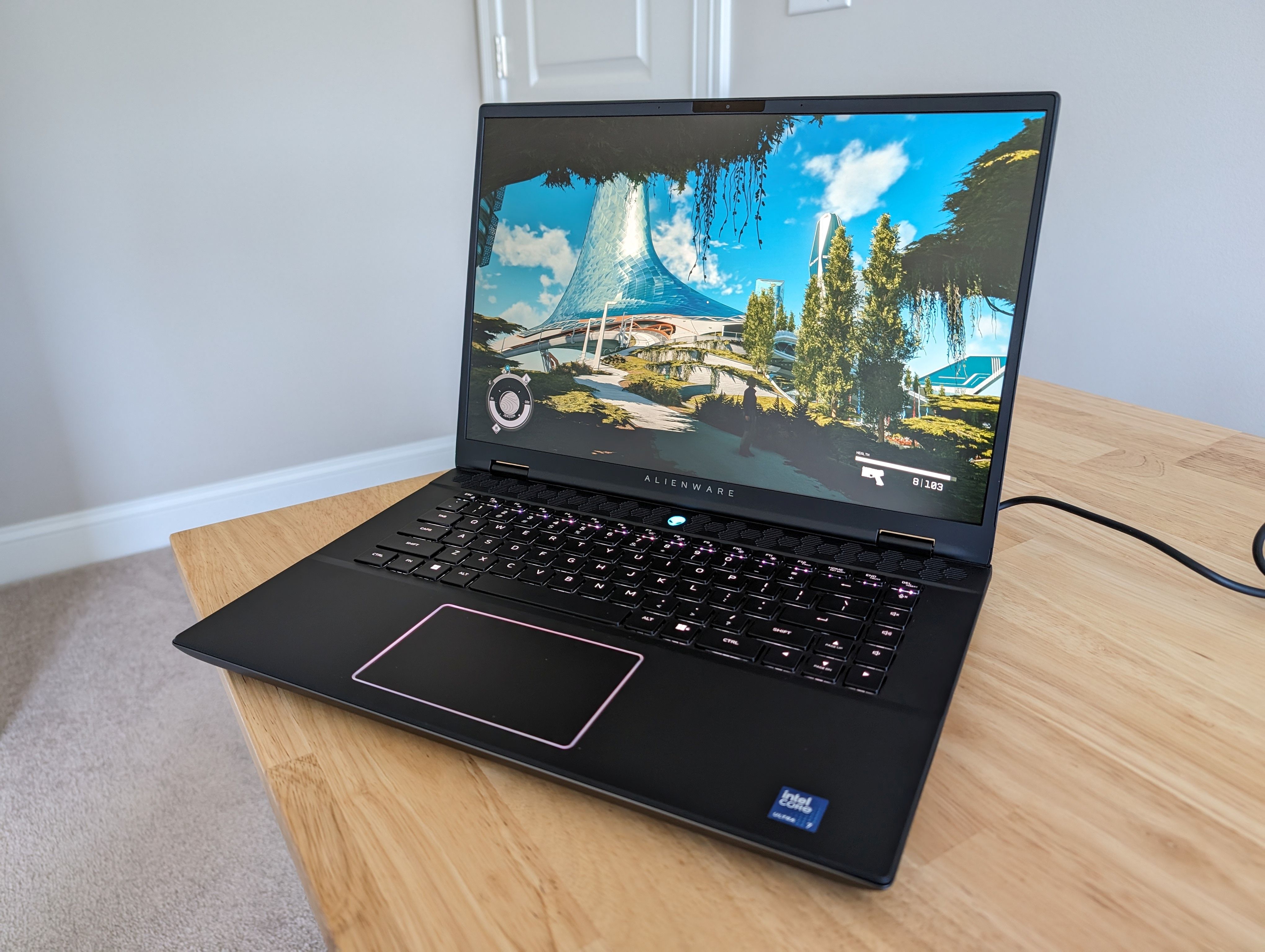
Pros
Great gaming performanceDurableLong battery life
Cons
Dim display
Why we like the Alienware m16 R2
The Alienware m16 R2 is a well-rounded gaming laptop, especially for the price and performance. Not only are you getting great graphics performance, but you’re also getting long battery life, an unusual combination for a gaming laptop. The Intel Core Ultra 7 155H CPU and the Nvidia GeForce RTX 4070 GPU are a powerful duo, as shown in our testing. It averaged 144 frames-per-second when running the Shadow of the Tomb Raider benchmark, which is nothing to sneeze at. According to our review, it’s just “four frames-per-second slower than the Razer Blade 16,” which is rocking a more powerful RTX 4090 GPU and a $3,000+ price tag. It also lasted 11 hours and fifteen minutes on a single charge, which is more than a full work day.
Who should buy the Alienware m16 R2
Anyone looking for a fantastic gaming laptop. You can play most games on the High or Ultra graphics preset and the 90 watt-hour battery will keep you going long into the night. The 1600p IPS display is also quite spacious at 16-inches and the 240Hz refresh rate should result in smooth gameplay. The picture quality is quite good, but it’s not an OLED panel, where the colors would be more saturated. While it’s not the brightest or most color rich display we’ve ever tested, it’s still fine for gaming. Besides, if you’re really desperate, you can always plug into an external monitor.
Alternative option: If you’re looking for the same great Alienware package with a bigger screen, the Alienware m18 R2 is worth considering. It offers strong gaming performance, an 18-inch display, and a fantastic mechanical keyboard with Cherry switches. That said, it’s very expensive and the laptop itself weighs a colossal nine pounds (!!!). Talk about a back-breaker! Alternatively, if you’re looking for even more firepower, the ROG Zephyrus G16 is a killer OLED-equipped laptop with RTX 4070, 4080, and 4090 options available.
Lenovo Legion 9i – Best high-end gaming laptop
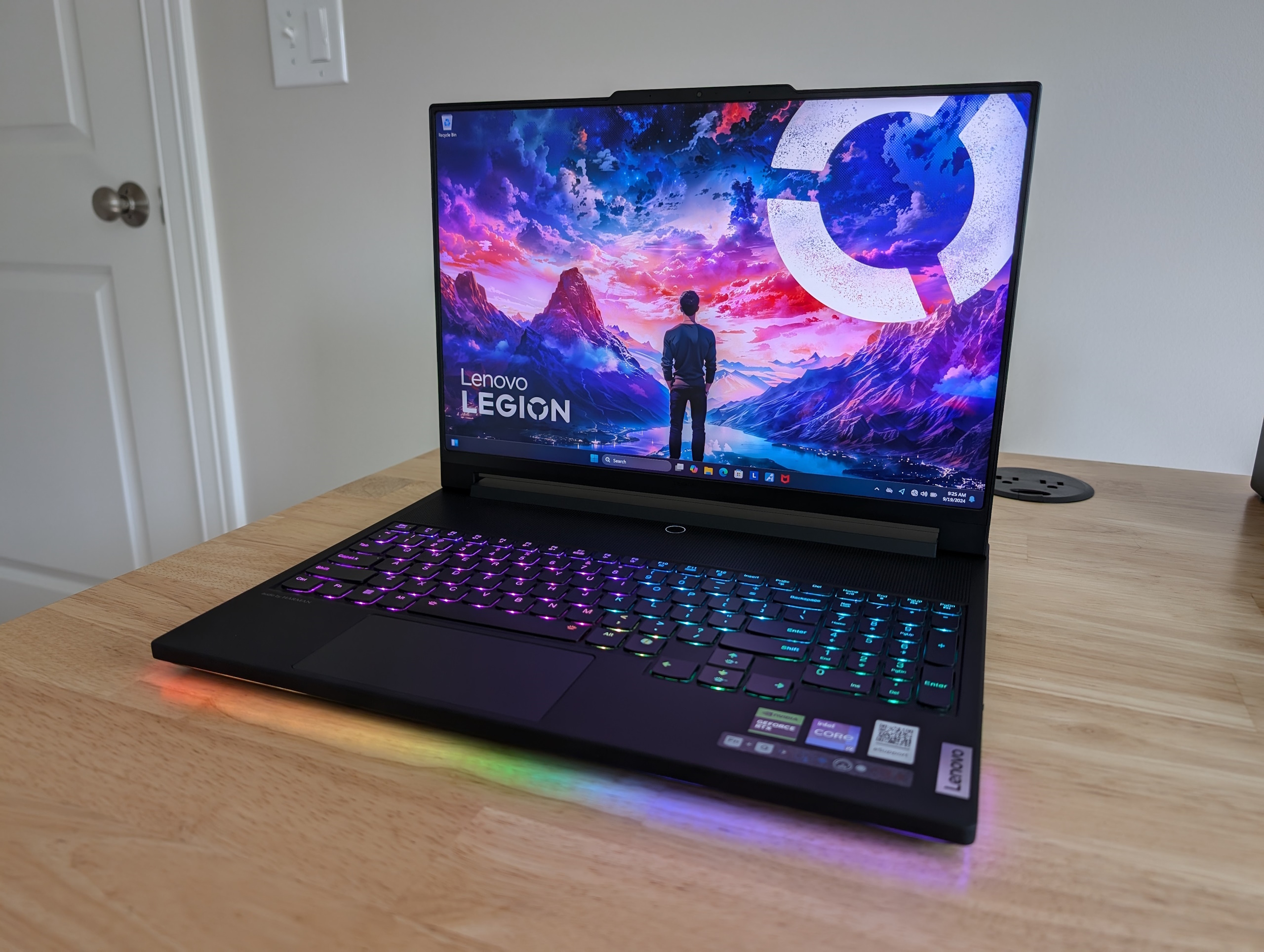
Pros
Top-of-the-line CPU and GPUBright and beautiful display with HDRLiquid cooling works wellLots of well-positioned ports
Cons
ExpensiveLow battery lifeNo Wi-Fi 7No facial recognitionBest Prices Today: $3129.99 at Lenovo
Why we like the Lenovo Legion 9i
The Lenovo Legion 9i offers incredible performance as well as a high-quality display. If you’re after the ultimate gaming experience, you can’t really get much better than this machine — but it costs an arm and a leg. For roughly $4,059 (at the time of the review), you’re getting an Intel Core i9-14900HX CPU and an Nvidia GeForce RTX 4090 GPU, a powerful combination that’ll chew through anything you throw at it. The 16-inch, 3200×2000 Mini-LED display can also deliver up to 1,200 nits of brightness, resulting in an “excellent HDR experience in games like Cyberpunk 2077,” according to our review.
Who should buy the Lenovo Legion 9i
Serious gamers with flexible budgets, that’s who. In addition to the powerful performance and stunning display, it’s also lightweight and cool to the touch, even under heavier loads. The one downside is the high price, so budget-conscious gamers will need to look elsewhere.
Alternative option: The Gigabyte Aorus 17X ($3,700) is another great gaming laptop to consider. Not only are you getting top-of-the-line hardware (an Intel Core i9-14900HX CPU and an Nvidia GeForce RTX 4090 GPU), you’re also getting a 17.3-inch, 2560×1440 IPS display with a ridiculously fast 240Hz refresh rate.
Read our full Lenovo Legion 9i review
Acer Nitro V 16 – Best gaming laptop under $1,000
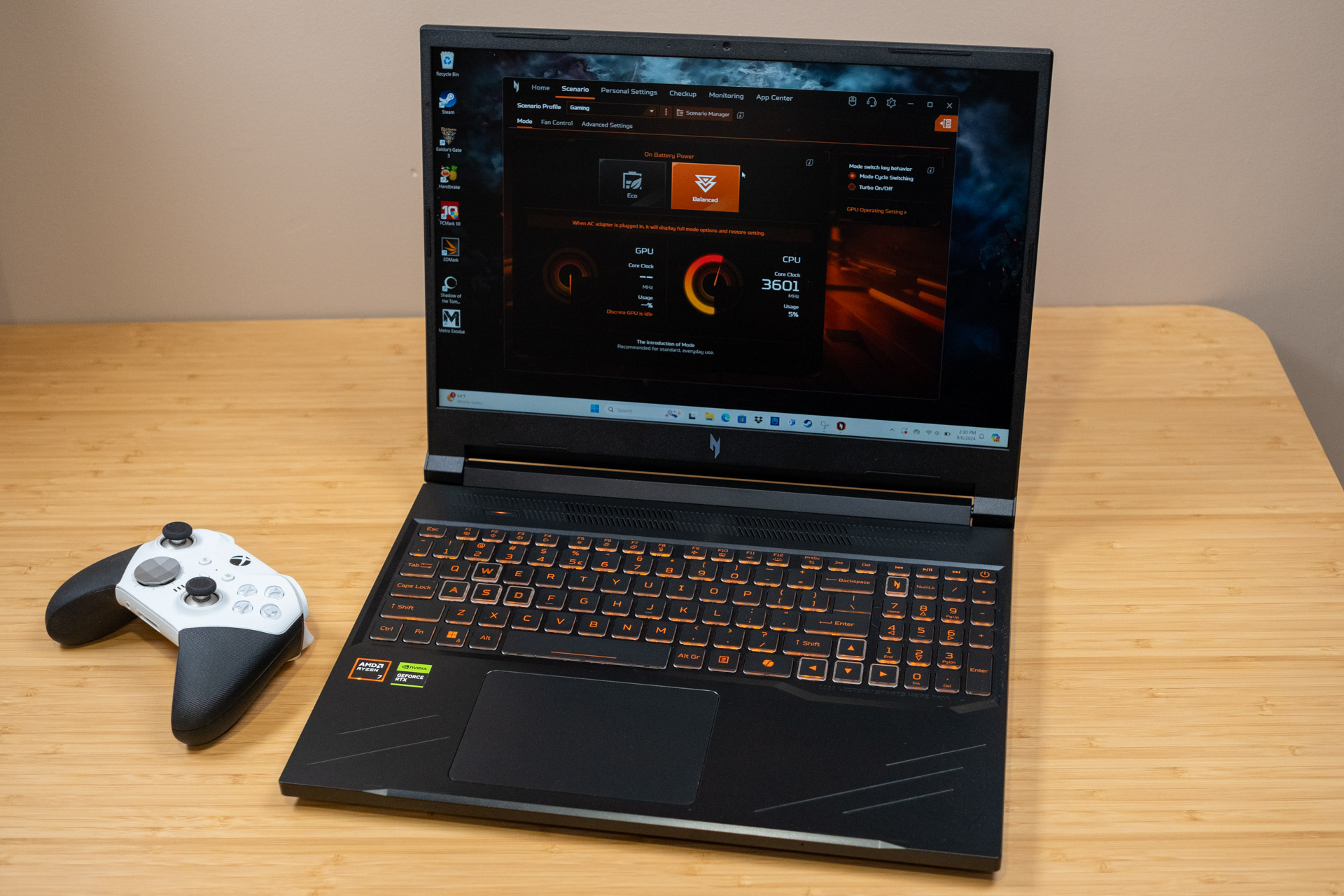
Pros
Solid performanceCompetitive priceDedicated button for quick performance mode switchingFast 165Hz display with good colors
Cons
Fully plastic buildMushy keyboardWeak battery life
Why we like the Acer Nitro V 16
The Acer Nitro V 16 offers good hardware for just under $1,000–full stop. Underneath the hood you’ll find an AMD Ryzen 7 8845HS CPU and an Nvidia GeForce RTX 4060 GPU, which is a good combination for playing games on the Medium or High graphics preset. The 1920×1200 IPS display is also quite large at 16 inches and has a refresh rate of 165Hz, which ideal for seamless gameplay. The battery life leaves little to be desired, though. It lasted four hours on a single charge, an anemic result compared to the Alienware m16 R2’s 11 hours. That said, it’s not a surprising result as gaming laptops typically have poor battery life.
Who should buy the Acer Nitro V 16
Anyone looking for an affordable gaming laptop! The Acer Nitro V 16 is powerful enough to run most games and the fast, large display is perfect for twitchy gamers. The thing about the Nitro V 16 is that it’s all plastic. I wouldn’t say it’s cheaply made, but you can really tell it’s made of plastic, especially around the touchpad and cooling vents. It feels sturdy enough, though perhaps not as sturdy as a laptop made of metal. The Acer Nitro V 16 is still a good laptop despite the slight dip in quality (regarding the outside shell). The performance is strong and reliable, which is what you want in any gaming laptop.
Read our full Acer Nitro V 16 review
HP Omen Transcend 14 – Most portable gaming laptop
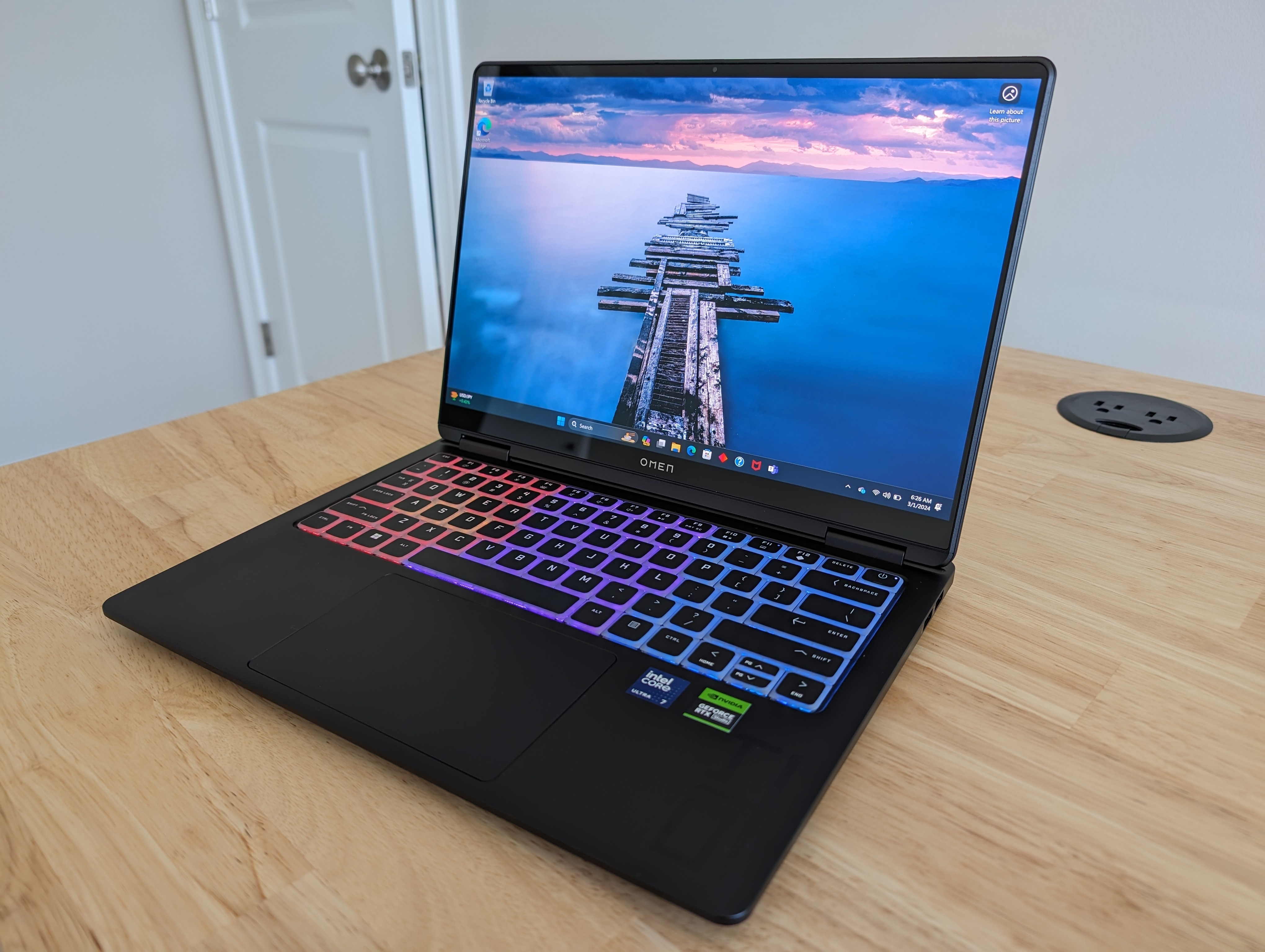
Pros
Compact and lightweightGorgeous OLED screenGood performance for the price
Cons
Keyboard is a bit mushyAnnoying bloatware
Why we like the HP Omen Transcend 14
The HP Omen Transcend 14 is a great machine because of its lightweight design (3.6 pounds!), stunning OLED display, and reliable performance for the price. Most gaming laptops tip the scales at around five pounds or more, so the fact that this machine is a little heavier than your standard ultraportable is downright impressive. In addition to its lightweight design, it also has an all-metal chassis, which means it’s rugged enough to handle the daily abuses of life. The hinge that connects the display to the keyboard deck also feels pretty solid. As for performance, it’s no slouch! Thanks to the Intel Core Ultra 7 155H CPU and the Nvidia GeForce RTX 4060 GPU, it achieved a respectable 93 frames-per-second during the Shadow of the Tomb Raider benchmark.
Who should buy the HP Omen Transcend 14
Anyone that likes to game on-the-go! It’s both lightweight and powerful, which is a rare combination when it comes to gaming laptops. Battery life is quite good, too. The HP Omen Transcend 14’s large 71 watt-hour battery lasted eight and a half hours on a single charge, which is impressive, as most gaming laptops tend to die at the four or five hour mark. The 14-inch 1800p OLED display is lovely as well. It has a maximum brightness level of 500 nits and a maximum refresh rate of 120Hz. According to our reviewer, who normally uses IPS displays on a day-to-day basis, “OLED displays like this one look incredibly beautiful” to him.
Alternative option: If you’re interested in an alternative option, check out the Asus ROG Zephyrus G14. It weighs a scant 3.31 pounds, which is a little less than our current pick. Although it has a nice OLED screen, an exquisite and portable design, and packs a decent punch in the performance department, its ho-hum webcam lands it behind the HP Omen Transcend 14 here.
Read our full HP Omen Transcend 14 review
Acer Chromebook 516 GE – Best gaming Chromebook
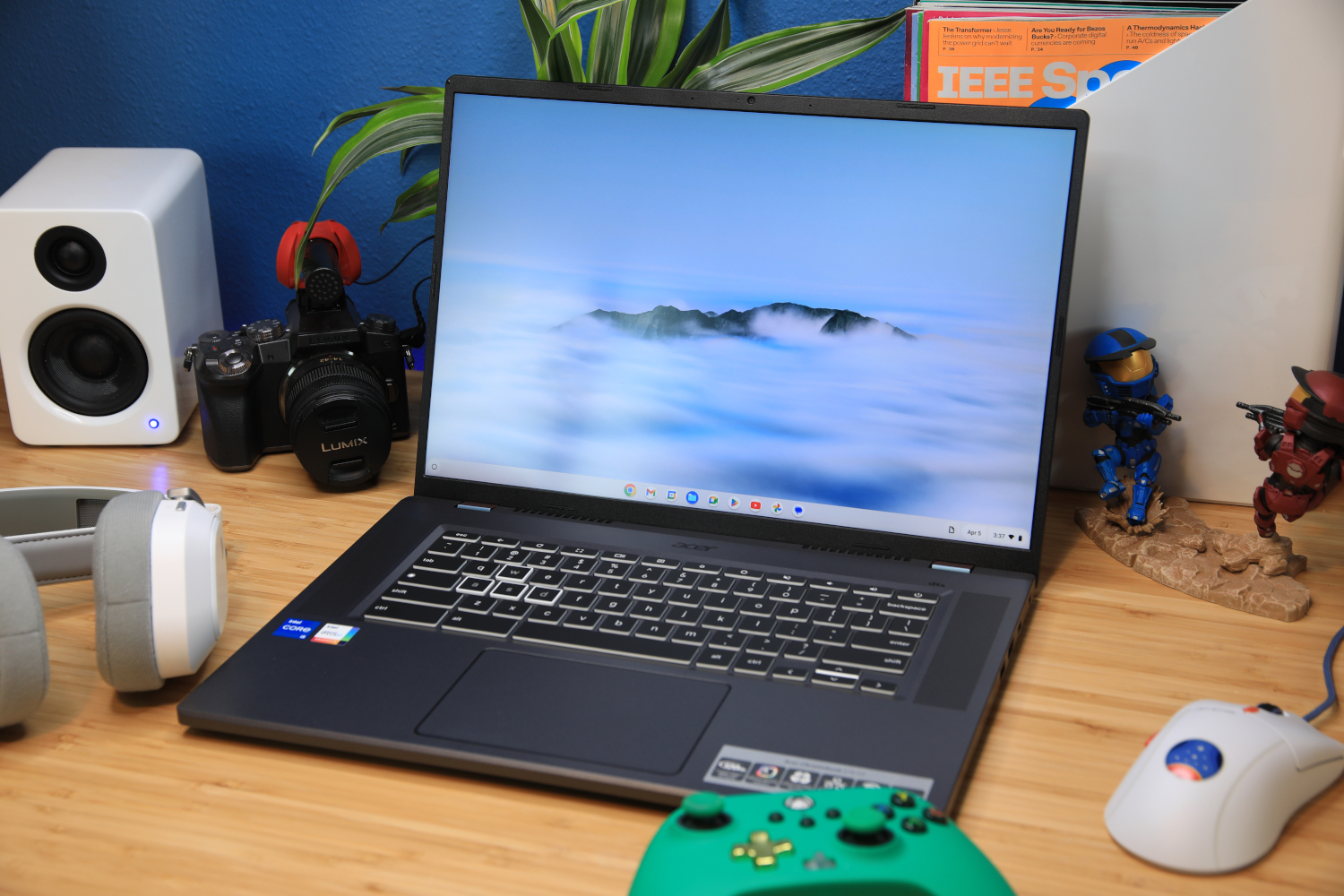
Pros
Attractive designExcellent CPU performancePlenty of wired and wireless connectivityHigh resolution 1600p display
Cons
Mediocre keyboard and touchpadDisappointing speakers and microphoneDisplay falls behind in contrast and color vibrancy
Why we like the Acer Chromebook 516 GE
The Acer Chromebook 516 GE offers reliable day-to-day performance as well as smooth cloud gaming gameplay, thanks in part to its fast, high-resolution display. Just so we’re clear–Chromebooks aren’t designed to run games locally, so you’ll need to be a member of a cloud gaming service like GeForce Now or Amazon Luna. Fortunately, this Chromebook has an Ethernet port, which scores major brownie ports as far as stable Internet connections go. Plus, compared to other budget Windows laptops, the $650 MSRP isn’t bad.
Connectivity options are good, too. You’re getting two USB-C 3.2 Gen 2, one HDMI, one Ethernet, and one 3.5mm combo audio. Additional goodies include a 1080p webcam, a 65 watt-hour battery, and a high refresh rate display (120Hz to be exact).
Who should buy the Acer Chromebook 516 GE
Anyone that wants to give cloud gaming a whirl on a reasonably priced Chromebook. The Acer Chromebook 516 GE features strong day-to-day performance and, according to our review, “gameplay felt perfectly smooth” while playing on GeForce Now. That said, if you want to install and run games locally, or have a poor internet connection, one of the Windows-based budget gaming laptops above would be a better option.
Read our full Acer Chromebook 516 GE review
Recent laptop reviews
Acer Swift 14 AI: The Acer Swift 14 AI offers solid all-around performance with the latest Snapdragon silicon and a generous selection of ports, but the trackpad is poor and Copilot+ features are still MIA.Lenovo IdeaPad 5x 2-in-1: The Lenovo IdeaPad 5x 2-in-1 delivers good bang for the buck.Samsung Galaxy Book5 Pro 360: The Samsung Galaxy Book5 Pro 360 is an excellent 2-in-1 laptop with long battery life thanks to Intel’s Lunar Lake hardware. But Lunar Lake’s focus on battery life comes at a cost, and this hardware doesn’t excel at multi-threaded CPU performance.Lenovo Chromebook Duet: The 2024 edition of the Chromebook Duet doubles down on its hybrid form factor and budget price. Lenovo has refined this design very well, and it remains a great choice if you want a cheap, reliable Chromebook that fits in small spaces and can do some light tablet duty. Just keep an eye on your tabs.Acer Swift 14 AI: The Acer Swift 14 AI isn’t exciting, but it packs well-rounded performance, good battery life, and a nice buffet of connectivity at a reasonable price.HP OmniBook Ultra Flip 14: If you’re looking for a solid 2-in-1 that gets the job done and you can get behind the idea of efficiency over power, then the HP OmniBook Ultra Flip 14 is worth your consideration.
How we test gaming laptops
The PCWorld team puts each and every Windows laptop through a series of benchmarks that test GPU and CPU performance, battery life, and so on. The idea is to push the laptop to its limits and then compare it against others we’ve tested. Below, you’ll find a breakdown of each test and the reasons why we run them.
PCMark 10: PCMark 10 is how we determine how well the laptop handles lighter tasks like web browsing, word processing, spreadsheets, and so on.HandBrake: HandBrake is more intensive than PCMark 10. It basically measures how long a laptop’s CPU takes to encode a beefy 30GB file. Cinebench: Cinebench is a brief stress test of the CPU cores. It does this by rendering a 2D scene over a short period of time.3DMark: 3DMark checks if 3D performance remains consistent over time by running graphic-intensive clips. Gaming tests: We benchmark each gaming laptop using several titles.Video rundown test: To gauge battery life, we loop a 4K video using Windows 10’s Movies & TV app until the laptop dies.
For a much more detailed explanation, check out how PCWorld tests laptops.
Buying Guide: How to pick the perfect gaming laptop
While there’s no such thing as a perfect gaming laptop, you can always find one that fits your budget and lifestyle. Need an affordable, entry-level gaming laptop? First of all, the GPU is the most important aspect to consider. If you think of a game like a vehicle, then the GPU is its driver. You’ll also need a good amount of SSD storage for your games library as well as a high refresh rate display, which keeps visuals looking nice and smooth.
For additional reading, be sure to check out this comprehensive guide on the gaming laptop features that matter most. If you’re on a strict budget, then you should dive into this piece about what a $1,000 gaming laptop really gets you. Otherwise, our FAQ below dives deep into several component considerations for gaming laptops
FAQ
1.
What’s the ‘best’ screen for a gaming laptop?
When you buy a gaming laptop, one of the most important decisions you’ll need to make regards the screen. After all, what you get on day one is what you’re stuck with until you junk the device. You could run an external monitor but then, what’s the point of a laptop? Look for an IPS or OLED display, though gaming laptops under $1,000 sometimes include a TN panel. You can get buy with a 60Hz display if you mostly play single-player games, but thankfully, most gaming laptops these days opt for faster 120Hz+ panels instead.
2.
What’s the ‘best’ screen size for a gaming laptop?
The size of the screen dictates the size of the laptop itself, and thus weight. You can’t, for example, get a 17-inch gaming laptop that’s four pounds (although MSI’s excellent GS75 gets awfully damned close at five), so think long and hard about whether you’re willing to take the weight penalty in exchange for the screen real estate.
If the laptop is going to be your only gaming machine, having a 17-inch screen might be ideal. We should also add that a 17.3-inch screen is easier on weaker eyes than a 15.5-inch screen. This is very much a matter of personal preference.
3.
What’s the ‘best’ screen resolution for a gaming laptop?
The buzzword today is “4K.” That high resolution delivers sharper photo viewing and more space for video editing, but that doesn’t mean it’s for everyone. Anything not using the panel’s native resolution of 3840×2180, such as games running at lower-than-4K resolution, won’t look quite as sharp unless you exponentially increase the graphics power of the laptop.
If you’re running at 1920×1080 resolution because your GPU can’t hit 60 fps at 4K, that feature is moot. For many gamers, 1920×1080 (1080p) or 2560×1440 (1440p) is more optimal.
4.
IPS vs. TN vs. OLED: What’s the difference?
The panel technology is also a key feature. IPS (in-plane switching) generally produces much greater color accuracy and superior off-axis viewing, but tends to lag in response times, which can lead to blurring. TN (twisted nematic) panels can offer far higher refresh rates and usually better response times than IPS, but can look washed out or just blah.
A middle-ground technology that’s appearing more often is VA (vertical alignment). VA is sometimes alternately referred to as “wide viewing angle” technology. (Many assume this to spec to be IPS, but it’s not). In our experience, we’ve found VA panels to run the gamut from being worthy competitors to IPS to being worse than the better TN panels.
Generally, if color accuracy is important, go IPS (a trademark of Sharp), and if you want the fastest response times go for a gaming-oriented TN panel. With the variability of VA, we recommend you check feedback from reviewers and users of a particular model.
The wildcard in all this is OLED. OLED-based panels have been used in phones for years but have recently migrated to larger screens in laptops. IPS, TN, and VA all use LEDs behind the screen or along the edges. “Black” is produced by a shutter-like mechanism that blocks light from coming through. As you can imagine, there’s usually some light leakage, which means the black tends to be gray.
OLED panels don’t rely on edge- or backlighting. Instead, each pixel generates its own light. To produce black, it just switches off the light. This amounts to truly stunning contrast ratios and vibrant colors. OLEDs also boast fantastic response times.
The negatives include smaller screen sizes (we haven’t seen anything larger than 15.6 inches yet), higher cost, and lack of support for variable refresh rate. OLED panels can also use more power than conventional methods if the image is on a white background.
5.
Should a gaming laptop have G-Sync or FreeSync support?
Okay, we called this section G-Sync and FreeSync, but the reality is, when it comes to beefy gaming laptops, it’s a GeForce GPU world. And that means it’s a G-Sync world. In a nutshell, Nvidia and AMD’s respective variable-refresh-rate technologies help synchronize the monitor and the GPU to greatly reduce screen tearing. Variable refresh rates can make gaming at 40 fps far smoother to your eyes than a screen without it.
The first variable-refresh-rate panels for laptops maxed out at 75Hz, only marginally better than the standard 60Hz. More recently, we’ve begun to see laptop panels that can push 120Hz, 144Hz and even 240Hz. This generally means smoother and sharper gaming to your eyes. It even helps smooth out everyday tasks such as scrolling a browser page or Word document.
The downside of high-refresh rate panels is the technology it’s available on: TN. As we said earlier, TN generally looks less vibrant and less accurate than IPS. The off-axis view is generally inferior, too. You’ll also need a far more powerful GPU to feed that high-refresh rate monitor at its native resolution.
One last very important note: G-Sync screens have to be connected directly to the laptop’s discrete GPU, which means a large hit in battery life. In most laptops without G-Sync, the Intel integrated graphics is connected directly to the screen, so the GPU can be turned off when not being used. So while G-Sync is beautiful to behold, the cost in battery life is huge.
Which is right for you? If it’s primarily a gaming laptop—go for a high refresh rate and G-Sync (or FreeSync, if you can find a laptop that supports it with a Radeon GPU). If you tend to also push pixels in Photoshop or do any color-critical work, skip variable refresh for an IPS panel.
6.
What should you look for in a gaming laptop keyboard and trackpad?
A new trend in gaming laptops is the offset trackpad, which is more conducive to gaming than a dead-center trackpad. The concept is sound, but anyone who actually cares about PC gaming will just plug in a mouse. The worst thing about that offset trackpad is when you try to use it for non-gaming purposes.
As far as keyboards go, the most important gaming feature is n-key rollover. This means the keyboard physically scans each key separately. If you wanted to, you could press 20 keys simultaneously and they’d all register, as each is independently wired. That probably sounds excessive, but keyboards that lack this feature can suffer missed keystrokes, which both ruins gameplay and hurts in everyday tasks. Anyone who’s used an Adobe product that might require a left-Alt, left-Shift, left-Ctrl plus two more keys to do something may have run into the limitations of non-n-key keyboards.
Other keyboard considerations include LED backlighting (which adds ambiance but does nothing for gameplay) and mechanical keys vs. membrane. Mechanical keys are excellent—but are available on only a handful of laptops that usually weigh a ton. We have seen a few designs with low-profile mechanical keyboards, but even we admit they can be an acquired taste.
7.
What kind of storage is best for a gaming laptop?
Having your games load from an SSD instead of a hard drive significantly cuts down on load times. But beyond that, we haven’t found it to matter that much whether it’s a super-fast NVMe PCIe drive or a slower SATA SSD.
What does matter more today is the size of the SSD rather than the interface it uses. With games now topping 50GB and some touching 100GBs, a once-spacious 256GB SSD will feel too small with just four games installed.
So when spec’ing out that gaming laptop, be mindful of just how much total storage you have. If you go for laptop with a small SSD and large hard drive combo, expect to install your games to the hard drive. If the laptop will have an SSD only, choose an absolute minimum of 512GB, with 1TB preferred.
8.
How much RAM do you need in a gaming laptop?
When laptop makers spec out gaming laptops, one of the levers they use to try to convince you to buy their product is upping the amount of RAM. It’s not hard to find gaming laptops with “upgraded” configurations that go from 16GB of RAM to 32GB.
While having an adequate amount of RAM is important for gaming, today’s games typically top out at 16GB of RAM, and sometimes can run fine with just 8GB of RAM. Most people should invest in a gaming laptop with 16GB of memory if possible, and it makes sense to opt for 32GB if you plan on holding onto your gaming laptop for a long time. Modern games are only getting more memory-ungry.
9.
Should a gaming laptop have dual-channel or single-channel RAM?
Besides the amount of memory, a couple of other important, but not critical, questions to ask is what clock speed and what mode. Modern CPUs let you run RAM in sets to increase the memory bandwidth.
More memory bandwidth immediately helps laptops that are running integrated graphics, but the conventional wisdom has long been that discrete GPUs in laptops don’t benefit as much because they have their own dedicated, much faster GDDR5 RAM to use. That’s typically the case, but the performance of today’s GPUs and CPUs can make this conventional wisdom wrong.
Gaming performance is often about a balance between the CPU and the GPU, and how graphically intensive a game is. With games that are graphically intensive, the GPU is the primary bottleneck on performance. Play a game that isn’t graphically intense, though, and the CPU can rapidly become the bottleneck on performance.
With the power of today’s GPUs, a lot of games, especially at a sedate resolution of 1920×1080, have shifted more performance to the CPU. The reason we’re talking about this now is if you rob the CPU of memory bandwidth, even a decently fast one, you can take a sizable hit in gaming performance.
The basic lesson is you should opt for dual-channel memory bandwidth configurations when possible. On a laptop spec sheet, you typically would see this expressed as “dual-channel” or “2 x 8” to indicate that two 8GB memory modules were used in a laptop.
Some laptop makers will express memory in clock speed, so you’ll see “DDR4/2,133 or DDR4/2,400.” While a higher memory clock does increase memory bandwidth, the impact isn’t quite as great as going from dual-channel to single-channel mode.
10.
How many CPU cores do you really need in a gaming laptop?
How many cores do you need in a gaming laptop? For most people on a budget, a 4-core CPU with Hyper-Threading will function just fine in most games, especially when combined with a lower-cost and lower performance GPU.
Still, if you have the extra cash, a 6-core CPU with Hyper-Threading is likely the sweet spot for today and tomorrow. If you plan to stream your gaming live or edit it, investing in a 6-core is recommended.
Intel and AMD’s top-end 8-plus-core CPUs will deliver the greatest benefit to those who might do other graphics-intensive tasks, such as 3D animation or video editing. If you also plan to record and stream video, the 8-core will offer a performance benefit there, too.
If you’re thinking, great, let me buy a 4-core Core i5 or Ryzen 5 CPU with a luxury laptop to save money, you usually can’t, because PC makers typically only offer budget CPUs with other budget parts. Why? Well, most budget shoppers can’t afford any luxury items, and most PC makers like to add in the extras to increase the profit.
11.
What GPU is best for a gaming laptop?
The single most important piece of hardware in a gaming laptop is undoubtedly the GPU. For AMD fans, the situation is as sad as it is in CPUs: It’s an Nvidia GeForce world. As with CPUs though, the good news is that the dominating products are top-notch.
The hardest part will be deciding just how much GPU you need. Our general guidance is to buy as fast a GPU as you can afford and are willing to heft. Generally, the faster the GPU (or GPUs), the larger and heavier the laptop. If you’re talking about playing on a higher-resolution panel of 2560×1440 at high-refresh rates, then keep increasing the amount of money spent on the GPU.
12.
What kind of battery life should a gaming laptop have?
The last topic we’ll cover is battery life. The best way to understand battery life on a gaming laptop is to accept that it’ll be horrible for all things gaming.
The minute you crank up a GPU on a gaming laptop to play a game, you’re basically limiting yourself to an hour or an hour and a half of battery runtime. Period. And in some cases, far less than that.
The only reason to consider battery life on a gaming laptop is if you want to use your laptop unplugged for non-gaming purposes. In that respect, you’ll find a lot of variance, with some offering decent battery life, albeit with a trade-off in gaming performance.
Author: Ashley Biancuzzo, Associate Editor, PCWorld

Ashley Biancuzzo manages all laptop and Chromebook coverage for PCWorld. She’s been covering consumer tech since 2016, and her work has appeared on USA Today, Reviewed, Polygon, Kotaku, StarWars.com, and Nerdist. In her spare time, she enjoys playing video games, reading science fiction, and hanging out with her rescue greyhound.
Recent stories by Ashley Biancuzzo:
Save $200 on the best laptop we’ve ever testedI’m PCWorld’s laptop fanatic. These are the best Black Friday laptop deals I’ve foundBest laptops under $500 in 2024: Best overall, best OLED laptop, and more




